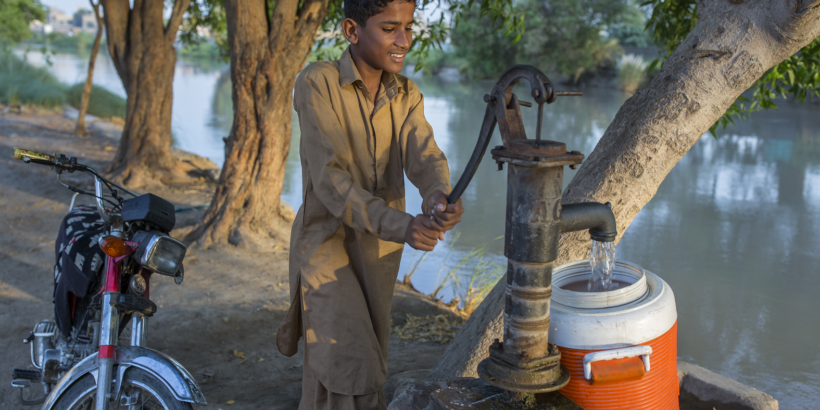Waterborne diseases like typhoid are rising in communities hit hardest by floods, droughts, and failing water infrastructure, conditions all worsened by climate change. The link between climate resilience and infectious disease prevention has never been stronger.
Floods, droughts, and disease: climate disruptions in action
Typhoid spreads by ingesting food or water contaminated by human feces containing Salmonella Typhi bacteria. The risk of contracting typhoid increases when major climate events disrupt safe water access and sanitation facilities.
In 2022, massive floods in Pakistan overwhelmed water and sanitation infrastructure, triggering widespread disease outbreaks including typhoid. Environmental surveillance during and immediately following monsoon rains detected high abundance of typhoid bacteria in wastewater and surface water. In urban centers, poor drainage and aging pipes made it impossible to separate drinking water from sewage, putting entire neighborhoods at risk of waterborne illnesses. In Kenya, heavy rains and flash flooding in 2024 led to damaged water, sanitation, and hygiene (WASH) infrastructure, contaminating water supplies and accelerating the spread of disease. At the same time, prolonged droughts limit availability of frequented safe water sources, forcing communities to use contaminated water sources and increasing risks of typhoid outbreaks, particularly in children. Together, these climate extremes underscore how limited and unreliable access to safe water leaves communities especially vulnerable to typhoid.
Water systems are climate solutions
Resilient water infrastructure is a powerful tool to reduce the burden of typhoid and build climate-adapted communities. Some examples of such infrastructure include:
- Piped, treated water to homes to reduce reliance on contaminated surface sources, such as lakes and streams.
- Flood-resistant water storage and elevated tanks to protect against waterborne pathogens during extreme weather.
- Point-of-use chlorination and filtration systems that can be rapidly deployed in disaster-prone areas.
- Environmental surveillance to detect typhoid bacteria in water systems.
In Nepal, integrated typhoid surveillance has been used to guide targeted interventions, combining typhoid conjugate vaccine (TCV) campaigns with improvements to water infrastructure. TCV is highly protective, preventing approximately 79 percent of typhoid cases, and modeling suggests that when vaccination is paired with improved household WASH, the combined effect could substantially reduce typhoid burden. In Bangladesh, high-burden urban areas now use typhoid environmental bacteriophages for typhoid surveillance, an increasingly useful approach as extreme weather events intensify. Bangladesh plans to introduce TCV this year, utilizing an integrated strategy of vaccination and WASH surveillance to control typhoid.
The cost of inaction
When water systems are neglected, the costs affect every part of society, and climate change is making those costs even higher. Outbreaks of typhoid lead to school closures, overwhelmed hospitals, and missed workdays. Children miss opportunities to learn and grow, while families face economic strain. In severe cases, outbreaks can escalate into humanitarian crises by stretching already burdened health systems and requiring expensive interventions.
Additionally, drug resistance continues to increase, making typhoid treatment increasingly challenging and costly. Preventing infection through clean water and vaccination is more critical than ever, as reliance on medical treatment alone becomes less effective.
Water investment is climate adaptation
The return on investment for water and sanitation is well established. According to global economic models, every dollar spent on safe water yields an estimated US$4 in reduced health costs and increased productivity. Investments must prioritize climate-resilient infrastructure, maintenance and monitoring to ensure water stays safe from source to tap, and community-led planning to ensure local knowledge informs strategies.
The role of vaccines in a warming world
While water system improvements are essential for long-term typhoid control, they are often costly and take considerable time to achieve. As countries work toward WASH goals, TCV serves as a vital bridge, especially in areas facing immediate climate threats. TCVs provide protection for children for at least four years and are a valuable tool for reducing disease burden, while also offering critical protection during climate emergencies when water and sanitation infrastructure may be further compromised.
Cover photo: A child uses a water pump in Hyderabad, Pakistan. Credit: TyVAC/Asim Hafeez.



